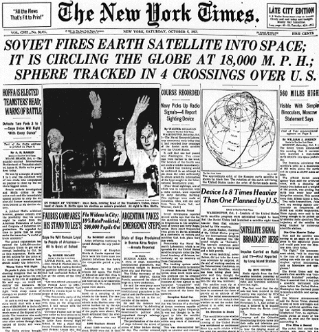Cold War Creativity and Sputnik Moments

“DeepSeek R1,” venture capitalist Marc Andreessen declared last week, “is AI’s Sputnik moment.” And as Sputnik – in its original 1957 instantiation and in its subsequent and repeated invocations – has always shaped education policy, particularly in regard to ed-tech, I thought I’d better say something.

But one of the things I strongly dislike about Internet culture is the expectation that everyone needs to respond to the latest news with a “take.” Too often this results in the rapid production of a lot of uninformed blather, which in turn serves to both overwhelm and undermine — not just expertise but also, more generally and maybe even more importantly, contemplation.
Even without generative AI helping in the production of written, video or graphic responses, we’re all mired in creating relentless outputs and updates (and/or sharing of someone else’s).
Indeed, I’d argue that the pressures to “say something” (and to say it quickly) is connected to (what I’m told is, at least) one of the major uses of generative AI: brainstorming.
Several years ago, Ta-Nehisi Coates explained to a class of journalism students (myself included) why he didn’t want a job as an op-ed writer for The New York Times. He said that he just didn’t have that many opinions, other than the kind that you share with a friend over beers; and these, he argued, really weren’t worthy of fluffing up to 800 words to meet some weekly quota. One of the greatest writers of my generation, Coates did not mean he couldn’t think of things to say; rather he didn’t feel like everything he was thinking was worth writing about – not without more thought, more research, more time. But such are the demands on all of us, NYT op-ed writers or not, to produce content; the demands we create, we “be creative.”
Creativity, as Samuel W. Franklin, notes in the subtitle to his 2023 book has a “surprisingly recent history.” The very modern idea of creativity emerged in the 1950s – and not as part of a “burgeoning youthful counterculture,” he notes, but from “an assorted cluster of academic psychologists, management gurus, advertising executives and engineers.” “The cult of creativity,” as Franklin calls it, was “driven by a desire to impart on science, technology, and consumer culture some of the qualities widely seen to be possessed by artists, such as nonconformity, passion for work, and a humane, even moral sensibility, in addition to, of course, a penchant for the new.” Atop a project of postwar capitalism was laid this gesture towards the most humane endeavor: creativity — the imperatives of personal expression inextricable from the imperatives of economic growth.
That you might feel like you struggle to “be creative” is, according to Franklin, a very recent malaise – and we are told again and again in subtle and not-so-subtle ways that creativity is something we all possess and, simultaneously, that we all lack. Not to worry, of course. There are techniques and technologies that help: generative AI now, of course, but also cushy chairs and whiteboards and multi-colored index cards and markers.
“Brainstorming,” a term that purposefully invoked a military movement, was coined in the late 1940s, but the idea really took off in the 1950s, involving then as now a number of methods aimed at generating ideas and solving problems “rapid fire” – a practice that, in that quintessentially American fashion, leaned heavily into “self-help” and self-actualization.
It was a practice embraced by both businesses and schools as part of larger Cold War concerns about conformity – fears of Soviet-style standardization, to be sure, but also the threats of “mass society” that seemed to be turning workers into automatons. Individualism, entrepreneurialism, creativity – these were aptitudes that could be cultivated in everyone through the aid of techniques like brainstorming – templates for free-thinking, problem-solving.
Businesses were particularly keen on these practices as brainstorming was a sort of “managed revolution,” Franklin argues – a period of workplace carnivalesque where freedom to speak out was briefly encouraged before order was restored (with management having extracted crucial “shop knowledge” from employees). These sessions offered reassurances to everyone that corporate life wasn’t so stultifying after all.
On October 4, 1957 news broke that the Soviet Union had successfully launched the first man-made satellite into space. Sputnik prompted a national panic, not simply over a looming Cold War – the possibility of Soviet spying or bombing, for example – but about the purported failures of the US education system.

"The schools never recovered from Sputnik" Gerald Bracey contends.





